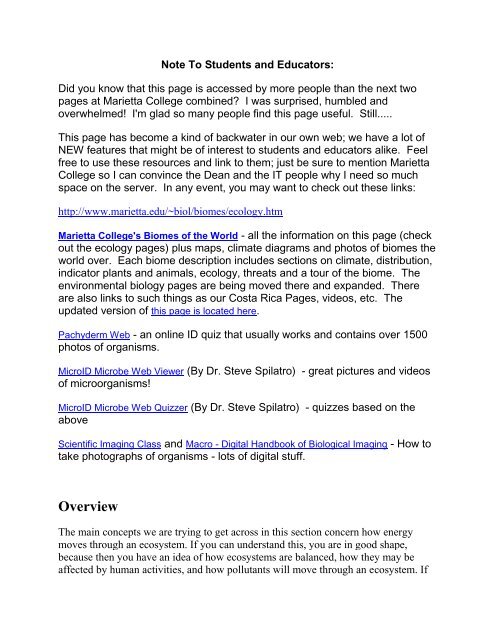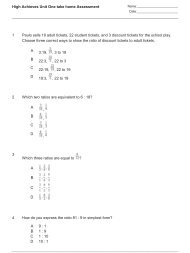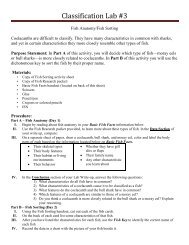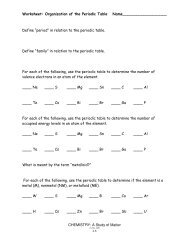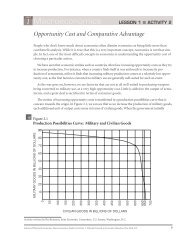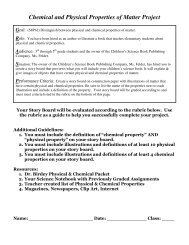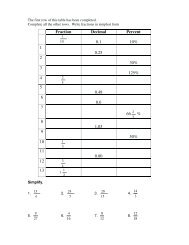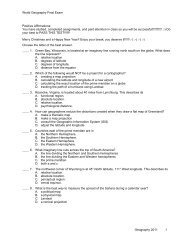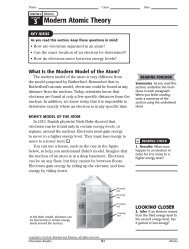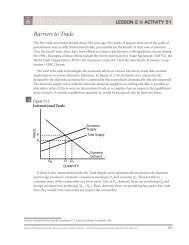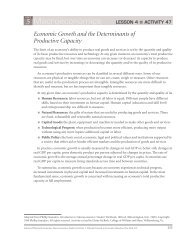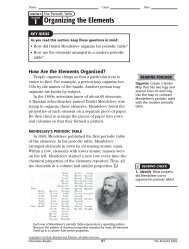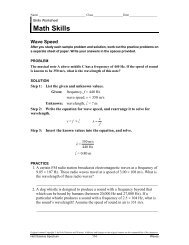Notes on Biogeochemical Cycles and Ecology.pdf
Notes on Biogeochemical Cycles and Ecology.pdf
Notes on Biogeochemical Cycles and Ecology.pdf
Create successful ePaper yourself
Turn your PDF publications into a flip-book with our unique Google optimized e-Paper software.
Note To Students <strong>and</strong> Educators:Did you know that this page is accessed by more people than the next twopages at Marietta College combined? I was surprised, humbled <strong>and</strong>overwhelmed! I'm glad so many people find this page useful. Still.....This page has become a kind of backwater in our own web; we have a lot ofNEW features that might be of interest to students <strong>and</strong> educators alike. Feelfree to use these resources <strong>and</strong> link to them; just be sure to menti<strong>on</strong> MariettaCollege so I can c<strong>on</strong>vince the Dean <strong>and</strong> the IT people why I need so muchspace <strong>on</strong> the server. In any event, you may want to check out these links:http://www.marietta.edu/~biol/biomes/ecology.htmMarietta College's Biomes of the World - all the informati<strong>on</strong> <strong>on</strong> this page (checkout the ecology pages) plus maps, climate diagrams <strong>and</strong> photos of biomes theworld over. Each biome descripti<strong>on</strong> includes secti<strong>on</strong>s <strong>on</strong> climate, distributi<strong>on</strong>,indicator plants <strong>and</strong> animals, ecology, threats <strong>and</strong> a tour of the biome. Theenvir<strong>on</strong>mental biology pages are being moved there <strong>and</strong> exp<strong>and</strong>ed. Thereare also links to such things as our Costa Rica Pages, videos, etc. Theupdated versi<strong>on</strong> of this page is located here.Pachyderm Web - an <strong>on</strong>line ID quiz that usually works <strong>and</strong> c<strong>on</strong>tains over 1500photos of organisms.MicroID Microbe Web Viewer (By Dr. Steve Spilatro) - great pictures <strong>and</strong> videosof microorganisms!MicroID Microbe Web Quizzer (By Dr. Steve Spilatro) - quizzes based <strong>on</strong> theaboveScientific Imaging Class <strong>and</strong> Macro - Digital H<strong>and</strong>book of Biological Imaging - How totake photographs of organisms - lots of digital stuff.OverviewThe main c<strong>on</strong>cepts we are trying to get across in this secti<strong>on</strong> c<strong>on</strong>cern how energymoves through an ecosystem. If you can underst<strong>and</strong> this, you are in good shape,because then you have an idea of how ecosystems are balanced, how they may beaffected by human activities, <strong>and</strong> how pollutants will move through an ecosystem. If
you had Biology 101, this should be review; if you had Geology 101, this is new stuff.Either way, it is pretty basic <strong>and</strong> you shouldn't have much trouble reading thismaterial or the associated material in the text.Roles of OrganismsOrganisms can be either producers or c<strong>on</strong>sumers in terms of energy flow through anecosystem. Producers c<strong>on</strong>vert energy from the envir<strong>on</strong>ment into carb<strong>on</strong> b<strong>on</strong>ds, suchas those found in the sugar glucose. Plants are the most obvious examples ofproducers; plants take energy from sunlight <strong>and</strong> use it to c<strong>on</strong>vert carb<strong>on</strong> dioxide intoglucose (or other sugars). Algae <strong>and</strong> cyanobacteria are also photosynthetic producers,like plants. Other producers include bacteria living around deep-sea vents. Thesebacteria take energy from chemicals coming from the Earth's interior <strong>and</strong> use it tomake sugars. Other bacteria living deep underground can also produce sugars fromsuch inorganic sources. Another word for producers is autotrophs.C<strong>on</strong>sumers get their energy from the carb<strong>on</strong> b<strong>on</strong>ds made by the producers. Anotherword for a c<strong>on</strong>sumer is a heterotroph. Based <strong>on</strong> what they eat, we can distinguishbetween 4 types of heterotrophs:c<strong>on</strong>sumer trophic level food sourceHerbivores primary plantsCarnivores sec<strong>on</strong>dary or higher animalsOmnivores all levels plants & animalsDetritivores --------------- detritusA trophic level refers to the organisms positi<strong>on</strong> in the food chain. Autotrophs are atthe base. Organisms that eat autotrophs are called herbivores or primary c<strong>on</strong>sumers.An organism that eats herbivores is a carnivore <strong>and</strong> a sec<strong>on</strong>dary c<strong>on</strong>sumer. Acarnivore which eats a carnivore which eats a herbivore is a tertiary c<strong>on</strong>sumer, <strong>and</strong> so<strong>on</strong>. It is important to note that many animals do not specialize in theirdiets. Omnivores (such as humans) eat both animals <strong>and</strong> plants. Further, except forsome specialists, most carnivores d<strong>on</strong>'t limit their diet to organisms of <strong>on</strong>ly <strong>on</strong>etrophic level. Frogs, for instance, d<strong>on</strong>'t discriminate between herbivorous <strong>and</strong>carnivorous bugs in their diet. If it's the right size, <strong>and</strong> moving at the right distance,chances are the frog will eat it. It's not as if the frog has brain cells to waste w<strong>on</strong>deringif it's going to mess up the food chain by being a sec<strong>on</strong>dary c<strong>on</strong>sumer <strong>on</strong>e minute <strong>and</strong>a quaternary c<strong>on</strong>sumer the next.
Energy Flow Through the EcosystemThe diagram above shows how both energy <strong>and</strong> inorganic nutrients flow through theecosystem. We need to define some terminology first. Energy "flows" through theecosystem in the form of carb<strong>on</strong>-carb<strong>on</strong> b<strong>on</strong>ds. When respirati<strong>on</strong> occurs, the carb<strong>on</strong>carb<strong>on</strong>b<strong>on</strong>ds are broken <strong>and</strong> the carb<strong>on</strong> is combined with oxygen to form carb<strong>on</strong>dioxide. This process releases the energy, which is either used by the organism (tomove its muscles, digest food, excrete wastes, think, etc.) or the energy may be lost asheat. The dark arrows represent the movement of this energy. Note that all energycomes from the sun, <strong>and</strong> that the ultimate fate of all energy in ecosystems is to be lostas heat. Energy does not recycle!!The other comp<strong>on</strong>ent shown in the diagram are the inorganic nutrients. They areinorganic because they do not c<strong>on</strong>tain carb<strong>on</strong>-carb<strong>on</strong> b<strong>on</strong>ds. These inorganic nutrientsinclude the phosphorous in your teeth, b<strong>on</strong>es, <strong>and</strong> cellular membranes; the nitrogen inyour amino acids (the building blocks of protein); <strong>and</strong> the ir<strong>on</strong> in your blood (to namejust a few of the inorganic nutrients). The movement of the inorganic nutrients isrepresented by the open arrows. Note that the autotrophs obtain these inorganic
nutrients from the inorganic nutrient pool, which is usually the soil or watersurrounding the plants or algae. These inorganic nutrients are passed from organism toorganism as <strong>on</strong>e organism is c<strong>on</strong>sumed by another. Ultimately, all organisms die <strong>and</strong>become detritus, food for the decomposers. At this stage, the last of the energy isextracted (<strong>and</strong> lost as heat) <strong>and</strong> the inorganic nutrients are returned to the soil or waterto be taken up again. The inorganic nutrients are recycled, the energy is not.Many of us, when we hear the word "nutrient" immediately think of calories <strong>and</strong> thecarb<strong>on</strong>-carb<strong>on</strong> b<strong>on</strong>ds that hold the caloric energy. IT IS VERY IMPORTANT thatyou be careful in your use of the word nutrient in this sense. When writing aboutenergy flow <strong>and</strong> inorganic nutrient flow in an ecosystem, you must be clear as to whatyou are referring. Unmodified by "inorganic" or "organic", the word "nutrient" canleave your reader unsure of what you mean. This is <strong>on</strong>e case in which the scientificmeaning of a word is very dependent <strong>on</strong> its c<strong>on</strong>text. Another example would be theword "respirati<strong>on</strong>", which to the laypers<strong>on</strong> usually refers to "breathing", but whichmeans "the extracti<strong>on</strong> of energy from carb<strong>on</strong>-carb<strong>on</strong> b<strong>on</strong>ds at the cellular level" tomost scientists (except those scientists studying breathing, who use respirati<strong>on</strong> in thelay sense).To summarize: In the flow of energy <strong>and</strong> inorganic nutrients through the ecosystem, afew generalizati<strong>on</strong>s can be made:1. The ultimate source of energy (for most ecosystems) is the sun2. The ultimate fate of energy in ecosystems is for it to be lost as heat.3. Energy <strong>and</strong> nutrients are passed from organism to organism through the foodchain as <strong>on</strong>e organism eats another.4. Decomposers remove the last energy from the remains of organisms.5. Inorganic nutrients are cycled, energy is not.Food Chains <strong>and</strong> Webs:A food chain is the path of food from a given final c<strong>on</strong>sumer back to a producer. Forinstance, a typical food chain in a field ecosystem might be:grass ---> grasshopper --> mouse ---> snake ---> hawkNote that even though I said the food chain is the path of food from a given finalc<strong>on</strong>sumer back to a producer we typically list a food chain from producer <strong>on</strong> the left(or at the bottom) to final c<strong>on</strong>sumer <strong>on</strong> the right (or at the top). Note to internati<strong>on</strong>alreaders: In Hebrew or Aramaic, or other languages which are read right-to-left, is itcustomary to list the food chains in the reverse order? By the way, you should be ableto look at the food chain above <strong>and</strong> identify the autotrophs <strong>and</strong> heterotrophs, <strong>and</strong>
classify each as a herbivore, carnivore, etc. You should also be able to determine thatthe hawk is a quaternary c<strong>on</strong>sumer.The real world, of course, is more complicated than a simple food chain. While manyorganisms do specialize in their diets (anteaters come to mind as a specialist), otherorganisms do not. Hawks d<strong>on</strong>'t limit their diets to snakes, snakes eat things other thanmice, mice eat grass as well as grasshoppers, <strong>and</strong> so <strong>on</strong>. A more realistic depicti<strong>on</strong> ofwho eats whom is called a food web; an example is shown below:It is when we have a picture of a food web in fr<strong>on</strong>t of us that the definiti<strong>on</strong> of foodchain makes more sense. We can now see that a food web c<strong>on</strong>sists of interlockingfood chains, <strong>and</strong> that the <strong>on</strong>ly way to untangle the chains is to trace back al<strong>on</strong>g a givenfood chain to its source.The food webs you see here are grazing food chains since at their base are producerswhich the herbivores then graze <strong>on</strong>. While grazing food chains are important, innature they are outnumbered by detritus-based food chains. In detritus-based foodchains, decomposers are at the base of the food chain, <strong>and</strong> sustain the carnivoreswhich feed <strong>on</strong> them. In terms of the weight (or biomass) of animals in manyecosystems, more of their body mass can be traced back to detritus than to livingproducers.Pyramids
Not these pyramids!The c<strong>on</strong>cept of biomass is important. It is a general principle that the further removeda trophic level is from its source (detritus or producer), the less biomass it will c<strong>on</strong>tain(biomass here would refer to the combined weight of all the organisms in the trophiclevel). This reducti<strong>on</strong> in biomass occurs for several reas<strong>on</strong>s:1. not everything in the lower levels gets eaten2. not everything that is eaten is digested3. energy is always being lost as heatIt is important to remember that the decrease in number is best detected in terms orbiomass. Numbers of organisms are unreliable in this case because of the greatvariati<strong>on</strong> in the biomass of individual organisms. For instance, squirrels feed <strong>on</strong>acorns. The oak trees in a forest will always outnumber the squirrels in terms ofcombined weight, but there may actually be more squirrels than oak trees. Rememberthat an individual oak tree is huge, weighing thous<strong>and</strong>s of kilograms, while anindividual squirrel weighs perhaps 1 kilogram at best. There are few excepti<strong>on</strong>s to thepyramid of biomass scheme. One occurs in aquatic systems where the algae may beboth outnumbered <strong>and</strong> outweighed by the organisms that feed <strong>on</strong> the algae. The algaecan support the greater biomass of the next trophic level <strong>on</strong>ly because they canreproduce as fast as they are eaten. In this way, they are never completely c<strong>on</strong>sumed.It is interesting to note that this excepti<strong>on</strong> to the rule of the pyramid of biomass also isa partial excepti<strong>on</strong> to at least 2 of the 3 reas<strong>on</strong>s for the pyramid of biomass givenabove. While not all the algae are c<strong>on</strong>sumed, a greater proporti<strong>on</strong> of them are, <strong>and</strong>while not completely digestible, algae are far more nutritious overall than the averagewoody plant is (most organisms cannot digest wood <strong>and</strong> extract energy from it).A generalizati<strong>on</strong> exists am<strong>on</strong>g ecologists that <strong>on</strong> average, about 10% of the energyavailable in <strong>on</strong>e trophic level will be passed <strong>on</strong> to the next; this is primarily due to the3 reas<strong>on</strong>s given above. Therefore, it is also reas<strong>on</strong>able to assume that in terms ofbiomass, each trophic level will weigh <strong>on</strong>ly about 10% of the level below it, <strong>and</strong> 10xas much as the level above it. It also seems, however, that every time I go to measure,test, or model this assumpti<strong>on</strong> I run into an inc<strong>on</strong>sistency, so take this generalizati<strong>on</strong>with a big grain of salt. Still, it comes in useful In terms of human diet <strong>and</strong> feeding theworld's populati<strong>on</strong>, c<strong>on</strong>sider this. If we all ate corn, there would be enough food for10x as many of us as compared to a world where we all eat beef (or chicken, fish,pork, etc.). Another way of looking at it is this. Every time you eat meat, you aretaking food out of the mouths of 9 other people, who could be fed with the plantmaterial that was fed to the animal you are eating. Of course, it's not quite that simple,but you get the general idea.
Biological Magnificati<strong>on</strong>Biological magnificati<strong>on</strong> is the tendency of pollutants to become c<strong>on</strong>centrated insuccessive trophic levels. Often, this is to the detriment of the organisms in whichthese materials c<strong>on</strong>centrate, since the pollutants are often toxic.Biomagnificati<strong>on</strong> occurs when organisms at the bottom of the food chain c<strong>on</strong>centratethe material above its c<strong>on</strong>centrati<strong>on</strong> in the surrounding soil or water. Producers, as wesaw earlier, take in inorganic nutrients from their surroundings. Since a lack of thesenutrients can limit the growth of the producer, producers will go to great lengths toobtain the nutrients. They will spend c<strong>on</strong>siderable energy to pump them into theirbodies. They will even take up more than they need immediately <strong>and</strong> store it, sincethey can't be "sure" of when the nutrient will be available again (of course, plantsd<strong>on</strong>'t think about such things, but, as it turns out, those plants, which, for whateverreas<strong>on</strong>, tended to c<strong>on</strong>centrate inorganic nutrients have d<strong>on</strong>e better over the years). Theproblem comes up when a pollutant, such as DDT or mercury, is present in theenvir<strong>on</strong>ment. Chemically, these pollutants resemble essential inorganic nutrients <strong>and</strong>are brought into the producer's body <strong>and</strong> stored "by mistake". This is the first step inbiomagnificati<strong>on</strong>; the pollutant is at a higher c<strong>on</strong>centrati<strong>on</strong> inside the producer than itis in the envir<strong>on</strong>ment.The sec<strong>on</strong>d stage of biomagnificati<strong>on</strong> occurs when the producer is eaten. Rememberfrom our discussi<strong>on</strong> of a pyramid of biomass that relatively little energy is availablefrom <strong>on</strong>e trophic level to the next. This means that a c<strong>on</strong>sumer (of any level) has toc<strong>on</strong>sume a lot of biomass from the lower trophic level. If that biomass c<strong>on</strong>tains thepollutant, the pollutant will be taken up in large quantities by the c<strong>on</strong>sumer. Pollutantsthat biomagnify have another characteristic. Not <strong>on</strong>ly are they taken up by theproducers, but they are absorbed <strong>and</strong> stored in the bodies of the c<strong>on</strong>sumers. This oftenoccurs with pollutants soluble in fat such as DDT or PCB's. These materials aredigested from the producer <strong>and</strong> move into the fat of the c<strong>on</strong>sumer. If the c<strong>on</strong>sumer iscaught <strong>and</strong> eaten, its fat is digested <strong>and</strong> the pollutant moves to the fat of the newc<strong>on</strong>sumer. In this way, the pollutant builds up in the fatty tissues of the c<strong>on</strong>sumers.Water-soluble pollutants usually cannot biomagnify in this way because they woulddissolve in the bodily fluids of the c<strong>on</strong>sumer. Since every organism loses water to theenvir<strong>on</strong>ment, as the water is lost the pollutant would leave as well. Alas, fat simplydoes not leave the body.The "best" example of biomagnificati<strong>on</strong> comes from DDT. This l<strong>on</strong>glivedpesticide (insecticide) has improved human health in many countries by killinginsects such as mosquitoes that spread disease. On the other h<strong>and</strong>, DDT is effective inpart because it does not break down in the envir<strong>on</strong>ment. It is picked up by organismsin the envir<strong>on</strong>ment <strong>and</strong> incorporated into fat. Even here, it does no real damage in
many organisms (including humans). In others, however, DDT is deadly or may havemore insidious, l<strong>on</strong>g-term effects. In birds, for instance, DDT interferes with thedepositi<strong>on</strong> of calcium in the shells of the bird's eggs. The eggs laid are very soft <strong>and</strong>easily broken; birds so afflicted are rarely able to raise young <strong>and</strong> this causes a declinein their numbers. This was so apparent in the early 1960's that it led the scientistRachel Cars<strong>on</strong> to postulate a "silent spring" without the sound of bird calls. Her book"Silent Spring" led to the banning of DDT, the search for pesticides that would notbiomagnify, <strong>and</strong> the birth of the "modern" envir<strong>on</strong>mental movement in the 1960's.Birds such as the bald eagle have made comebacks in resp<strong>on</strong>se to the banning of DDTin the US. Ir<strong>on</strong>ically, many of the pesticides which replaced DDT are more dangerousto humans, <strong>and</strong>, without DDT, disease (primarily in the tropics) claims more humanlives.Summary:In order for a pollutant to biomagnify, the following c<strong>on</strong>diti<strong>on</strong>s must be met:1. The pollutant must be l<strong>on</strong>g-lived.2. The pollutant must be c<strong>on</strong>centrated by the producers.3. The pollutant must be fat-soluble.You can read more about biological magnificati<strong>on</strong> in the next secti<strong>on</strong>.Human vs. Natural Food ChainsHuman civilizati<strong>on</strong> is dependent <strong>on</strong> agriculture. Only with agriculture can a fewpeople feed the rest of the populati<strong>on</strong>; the part of the populati<strong>on</strong> freed from raisingfood can then go <strong>on</strong> to do all the things we associate with civilizati<strong>on</strong>. Agriculturemeans manipulating the envir<strong>on</strong>ment to favor plant species that we can eat. Inessence, humans manipulate competiti<strong>on</strong>, allowing favored species (crops) to thrive<strong>and</strong> thwarting species which might otherwise crowd them out (weeds). In essence,with agriculture we are creating a very simple ecosystem. At most, it has <strong>on</strong>ly threelevels - producers (crops), primary c<strong>on</strong>sumers (livestock, humans) <strong>and</strong> sec<strong>on</strong>daryc<strong>on</strong>sumers (humans). This means that little energy is lost between tropic levels, sincethere are fewer trophic levels present.This is good for humans, but what type of "ecosystem" have we created? Agriculturalecosystems have several problems. First, we create m<strong>on</strong>ocultures, or fields with <strong>on</strong>ly<strong>on</strong>e crop. This is simplest for planting, weeding, <strong>and</strong> harvesting, but it also packsmany similar plants into a small area, creating a situati<strong>on</strong> ideal for disease <strong>and</strong> insectpests. In natural ecosystems, plants of <strong>on</strong>e species are often scattered. Insects, whichoften specialize <strong>on</strong> feeding <strong>on</strong> a particular plant species, have a hard time finding the
scattered plants. Without food, the insect populati<strong>on</strong>s are kept in check. In a field ofcorn however, even the most inept insect can find a new host plant with a jump in anydirecti<strong>on</strong>. Likewise, disease is more easily spread if the plants are in close proximity.It takes lots of chemicals (pesticides) to keep a m<strong>on</strong>oculture going.Another problem with human agriculture is that we rely <strong>on</strong> relatively few plants forfood. If the corn <strong>and</strong> rice crops failed worldwide in the same year, we would be hardpressedto feed every<strong>on</strong>e (not that we're doing a great job of it now). Naturalecosystems usually have alternate sources of food available if <strong>on</strong>e fails.A final problem associated with agroecosystems is the problem of inorganic nutrientrecycling. In a natural ecosystem, when a plant dies it fall to the ground <strong>and</strong> rots, <strong>and</strong>its inorganic nutrients are returned to the soil from which they were taken. In humanagriculture, however, we harvest the crop, truck it away, <strong>and</strong> flush it down the toilet tobe run off in the rivers to the ocean. Aside from the water polluti<strong>on</strong> problems thiscauses, it should be obvious to you that the nutrients are not returned to the fields.They have to be replaced with chemical fertilizers, <strong>and</strong> that means mining,transportati<strong>on</strong>, electricity, etc. Also, the chemical fertilizers tend to run off the fields(al<strong>on</strong>g with soil disrupted by cultivati<strong>on</strong>) <strong>and</strong> further pollute the water.Some soluti<strong>on</strong>s are at h<strong>and</strong>, but they bring <strong>on</strong> new problems, too. No-till farming usesherbicides to kill plants in a field; the crop is then planted through the dead plantswithout plowing up the soil. This reduced soil <strong>and</strong> fertilizer erosi<strong>on</strong>, but the herbicidesthemselves may damage ecosystems. In many areas, sewage sludge is returned tofields to act as a fertilizer. This reduces the need for chemical fertilizers, but stillrequires a lot of energy to haul the sludge around. Further, if <strong>on</strong>e is not careful, thingssuch as household chemicals <strong>and</strong> heavy metals may c<strong>on</strong>taminate the sewage sludge<strong>and</strong> biomagnify in the crops which we would then eat.BioGeoChemical <strong>Cycles</strong>.We have already seen that while energy does not cycle through an ecosystem,chemicals do. The inorganic nutrients cycle through more than the organisms,however, they also enter into the atmosphere, the oceans, <strong>and</strong> even rocks. Sincethese chemicals cycle through both the biological <strong>and</strong> the geological world, we callthe overall cycles biogeochemical cycles. Each chemical has its own unique cycle, butall of the cycles do have some things in comm<strong>on</strong>. Reservoirs are those parts of thecycle where the chemical is held in large quantities for l<strong>on</strong>g periods of time.In exchange pools, <strong>on</strong> the other h<strong>and</strong>, the chemical is held for <strong>on</strong>ly a short time. Thelength of time a chemical is held in an exchange pool or a reservoir is termedits residence time. The oceans are a reservoir for water, while a cloud is an exchange
pool. Water may reside in an ocean for thous<strong>and</strong>s of years, but in a cloud for a fewdays at best. The biotic community includes all living organisms. This communitymay serve as an exchange pool (although for some chemicals like carb<strong>on</strong>, bound in asequoia for a thous<strong>and</strong> years, it may seem more like a reservoir), <strong>and</strong> also serve tomove chemicals from <strong>on</strong>e stage of the cycle to another. For instance, the trees of thetropical rain forest bring water up from the forest floor to be evaporated into theatmosphere. Likewise, coral endosymbi<strong>on</strong>ts take carb<strong>on</strong> from the water <strong>and</strong> turn itinto limest<strong>on</strong>e rock. The energy for most of the transportati<strong>on</strong> of chemicals from <strong>on</strong>eplace to another is provided either by the sun or by the heat released from the mantle<strong>and</strong> core of the Earth.While all inorganic nutrients cycle, we will focus <strong>on</strong> <strong>on</strong>ly 4 of the most importantcycles - water, carb<strong>on</strong> (<strong>and</strong> oxygen), nitrogen, <strong>and</strong> phosphorous.The Water Cycle:
Key Features: In the water cycle, energy is supplied by the sun, which drivesevaporati<strong>on</strong> whether it be from ocean surfaces or from treetops. The sun also providesthe energy which drives the weather systems which move the water vapor (clouds)from <strong>on</strong>e place to another (otherwise, it would <strong>on</strong>ly rain over the oceans).Precipitati<strong>on</strong> occurs when water c<strong>on</strong>denses from a gaseous state in the atmosphere <strong>and</strong>falls to earth. Evaporati<strong>on</strong> is the reverse process in which liquid water becomesgaseous. Once water c<strong>on</strong>denses, gravity takes over <strong>and</strong> the water is pulled to the
ground. Gravity c<strong>on</strong>tinues to operate, either pulling thewater underground(groundwater) or across the surface (runoff). In either event, gravityc<strong>on</strong>tinues to pull water lower <strong>and</strong> lower until it reaches the oceans (in most cases; theGreat Salt Lake, Dead Sea, Caspian Sea, <strong>and</strong> other such depressi<strong>on</strong>s may also serve asthe lowest basin into which water can be drawn). Frozen water may be trapped incooler regi<strong>on</strong>s of the Earth (the poles, glaciers <strong>on</strong> mountaintops, etc.) as snow or ice,<strong>and</strong> may remain as such for very l<strong>on</strong>g periods of time. Lakes, p<strong>on</strong>ds,<strong>and</strong> wetl<strong>and</strong>s form where water is temporarily trapped. The oceans are salty becauseany weathering of minerals that occurs as the water runs to the ocean will add to themineral c<strong>on</strong>tent of the water, but water cannot leave the oceans except by evaporati<strong>on</strong>,<strong>and</strong> evaporati<strong>on</strong> leaves the minerals behind. Thus, rainfall <strong>and</strong> snowfall are comprisedof relatively clean water, with the excepti<strong>on</strong> of pollutants (such as acids) picked up asthe waster falls through the atmosphere. Organisms play an important role in the watercycle. As you know, most organisms c<strong>on</strong>tain a significant amount of water (up to 90%of their body weight). This water is not held for any length of time <strong>and</strong> moves out ofthe organism rather quickly in most cases. Animals <strong>and</strong> plants lose water throughevaporati<strong>on</strong> from the body surfaces, <strong>and</strong> through evaporati<strong>on</strong> from the gas exchangestructures (such as lungs). In plants, water is drawn in at the roots <strong>and</strong> moves to thegas exchange organs, the leaves, where it evaporates quickly. This special case iscalled transpirati<strong>on</strong> because it is resp<strong>on</strong>sible for so much of the water that enters theatmosphere. In both plants <strong>and</strong> animals, the breakdown of carbohydrates (sugars) toproduce energy (respirati<strong>on</strong>) produces both carb<strong>on</strong> dioxide <strong>and</strong> water as wasteproducts. Photosynthesis reverses this reacti<strong>on</strong>, <strong>and</strong> water <strong>and</strong> carb<strong>on</strong> dioxide arecombined to form carbohydrates. Now you underst<strong>and</strong> the relevance of the termcarbohydrate; it refers to the combinati<strong>on</strong> of carb<strong>on</strong> <strong>and</strong> water in the sugars we callcarbohydrates.Carb<strong>on</strong> Cycle
Once you underst<strong>and</strong> the water cycle, the carb<strong>on</strong> cycle is relatively simple. From abiological perspective, the key events here are the complementary reacti<strong>on</strong>s ofrespirati<strong>on</strong> <strong>and</strong> photosynthesis. Respirati<strong>on</strong> takes carbohydrates <strong>and</strong> oxygen <strong>and</strong>combines them to produce carb<strong>on</strong> dioxide, water, <strong>and</strong> energy. Photosynthesis takescarb<strong>on</strong> dioxide <strong>and</strong> water <strong>and</strong> produces carbohydrates <strong>and</strong> oxygen. The outputs ofrespirati<strong>on</strong> are the inputs of photosynthesis, <strong>and</strong> the outputs of photosynthesis are theinputs of respirati<strong>on</strong>. The reacti<strong>on</strong>s are also complementary in the way they deal withenergy. Photosynthesis takes energy from the sun <strong>and</strong> stores it in the carb<strong>on</strong>-carb<strong>on</strong>b<strong>on</strong>ds of carbohydrates; respirati<strong>on</strong> releases that energy. Both plants <strong>and</strong> animalscarry <strong>on</strong> respirati<strong>on</strong>, but <strong>on</strong>ly plants (<strong>and</strong> other producers) can carry <strong>on</strong>photosynthesis. The chief reservoirs for carb<strong>on</strong> dioxide are in the oceans <strong>and</strong> in rock.Carb<strong>on</strong> dioxide dissolves readily in water. Once there, it may precipitate (fall out ofsoluti<strong>on</strong>) as a solid rock known as calcium carb<strong>on</strong>ate (limest<strong>on</strong>e). Corals <strong>and</strong> algaeencourage this reacti<strong>on</strong> <strong>and</strong> build up limest<strong>on</strong>e reefs in the process. On l<strong>and</strong> <strong>and</strong> in thewater, plants take up carb<strong>on</strong> dioxide <strong>and</strong> c<strong>on</strong>vert it into carbohydrates throughphotosynthesis. This carb<strong>on</strong> in the plants now has 3 possible fates. It can be liberatedto the atmosphere by the plant through respirati<strong>on</strong>; it can be eaten by an animal, or itcan be present in the plant when the plant dies. Animals obtain all their carb<strong>on</strong> in theirfood, <strong>and</strong>, thus, all carb<strong>on</strong> in biological systems ultimately comes from plants
(autotrophs). In the animal, the carb<strong>on</strong> also has the same 3 possible fates. Carb<strong>on</strong> fromplants or animals that is released to the atmosphere through respirati<strong>on</strong> will either betaken up by a plant in photosynthesis or dissolved in the oceans. When an animal or aplant dies, 2 things can happen to the carb<strong>on</strong> in it. It can either be respired bydecomposers (<strong>and</strong> released to the atmosphere), or it can be buried intact <strong>and</strong>ultimately form coal, oil, or natural gas (fossil fuels). The fossil fuels can be mined<strong>and</strong> burned in the future; releasing carb<strong>on</strong> dioxide to the atmosphere. Otherwise, thecarb<strong>on</strong> in limest<strong>on</strong>e or other sediments can <strong>on</strong>ly be released to the atmosphere whenthey are subducted <strong>and</strong> brought to volcanoes, or when they are pushed to the surface<strong>and</strong> slowly weathered away. Humans have a great impact <strong>on</strong> the carb<strong>on</strong> cycle becausewhen we burn fossil fuels we release excess carb<strong>on</strong> dioxide into the atmosphere. Thismeans that more carb<strong>on</strong> dioxide goes into the oceans, <strong>and</strong> more is present in theatmosphere. The latter c<strong>on</strong>diti<strong>on</strong> causes global warming, because the carb<strong>on</strong> dioxidein the atmosphere allows more energy to reach the Earth from the sun than it allows toescape from the Earth into space.The Oxygen Cycle:If you look back at the carb<strong>on</strong> cycle, you will see that we have also described theoxygen cycle, since these atoms often are combined. Oxygen is present in the carb<strong>on</strong>dioxide, in the carbohydrates, in water, <strong>and</strong> as a molecule of two oxygen atoms.Oxygen is released to the atmosphere by autotrophs during photosynthesis <strong>and</strong> takenup by both autotrophs <strong>and</strong> heterotrophs during respirati<strong>on</strong>. In fact, all of the oxygen inthe atmosphere is biogenic; that is, it was released from water through photosynthesisby autotrophs. It took about 2 billi<strong>on</strong> years for autotrophs (mostly cyanobacteria) toraise the oxygen c<strong>on</strong>tent of the atmosphere to the 21% that it is today; this opened thedoor for complex organisms such as multicellular animals, which need a lot ofoxygen.The Nitrogen Cycle:
The nitrogen cycle is <strong>on</strong>e of the most difficult of the cycles to learn, simply becausethere are so many important forms of nitrogen, <strong>and</strong> because organisms are resp<strong>on</strong>siblefor each of the interc<strong>on</strong>versi<strong>on</strong>s. Remember that nitrogen is critically important informing the amino porti<strong>on</strong>s of the amino acids which in turn form the proteins of yourbody. Proteins make up skin <strong>and</strong> muscle, am<strong>on</strong>g other important structural porti<strong>on</strong>s ofyour body, <strong>and</strong> all enzymes are proteins. Since enzymes carry out almost all of thechemical reacti<strong>on</strong>s in your body, it's easy to see how important nitrogen is. The chiefreservoir of nitrogen is the atmosphere, which is about 78% nitrogen. It is here wereach <strong>on</strong>e of the limits of the hypertext language currently (1995-1996) most in vogue<strong>on</strong> the WWW. This versi<strong>on</strong> does not allow for superscripts or subscripts, so I willhave to stick to the l<strong>on</strong>ger chemical names. Nitrogen gas in the atmosphere iscomposed of two nitrogen atoms bound to each other. It is a pretty n<strong>on</strong>-reactive gas; ittakes a lot of energy to get nitrogen gas to break up <strong>and</strong> combine with other things,such as carb<strong>on</strong> or oxygen. Nitrogen gas can be taken from the atmosphere (fixed) intwo basic ways. First, lightning provides enough energy to "burn" the nitrogen <strong>and</strong> fixit in the form of nitrate, which is a nitrogen with three oxygens attached. This processis duplicated in fertilizer factories to produce nitrogen fertilizers. Biology 101 studentswill also recall the experiments of Stanley Miller, who used electrical discharges toshow how nitrogen in the Earth's early atmosphere might have combined to form
amino acids. The other form of nitrogen fixati<strong>on</strong> is by nitrogen fixing bacteria, whouse special enzymes instead of the extreme amount of energy found in lightning to fixnitrogen. These nitrogen-fixing bacteria come in three forms: some are free-living inthe soil; some form symbiotic, mutualistic associati<strong>on</strong>s with the roots of bean plants<strong>and</strong> other legumes (rhizobial bacteria); <strong>and</strong> the third form of nitrogen-fixing bacteriaare the photosynthetic cyanobacteria (blue-green algae) which are found mostcomm<strong>on</strong>ly in water. All of these fix nitrogen, either in the form of nitrate or in theform of amm<strong>on</strong>ia (nitrogen with 3 hydrogens attached). Most plants can take upnitrate <strong>and</strong> c<strong>on</strong>vert it to amino acids. Animals acquire all of their amino acids whenthey eat plants (or other animals). When plants or animals die (or release waste) thenitrogen is returned to the soil. The usual form of nitrogen returned to the soil inanimal wastes or in the output of the decomposers, is amm<strong>on</strong>ia. Amm<strong>on</strong>ia is rathertoxic, but, fortunately there are nitrite bacteria in the soil <strong>and</strong> in the water which takeup amm<strong>on</strong>ia <strong>and</strong> c<strong>on</strong>vert it to nitrite, which is nitrogen with two oxygens. Nitrite isalso somewhat toxic, but another type of bacteria, nitrate bacteria, take nitrite <strong>and</strong>c<strong>on</strong>vert it to nitrate, which can be taken up by plants to c<strong>on</strong>tinue the cycle. We nowhave a cycle set up in the soil (or water), but what returns nitrogen to the air? It turnsout that there are denitrifying bacteria which take the nitrate <strong>and</strong> combine the nitrogenback into nitrogen gas.The nitrogen cycle has some important practical c<strong>on</strong>siderati<strong>on</strong>s, as any<strong>on</strong>e who hasever set up a saltwater fish tank has found out. It takes several weeks to set up such atank, because you must have sufficient numbers of nitrite <strong>and</strong> nitrate bacteria presentto detoxify the amm<strong>on</strong>ia produced by the fish <strong>and</strong> decomposers in the tank.Otherwise, the amm<strong>on</strong>ia levels in the tank will build up <strong>and</strong> kill the fish. This isusually not a problem in freshwater tanks for two reas<strong>on</strong>s. One, the pH in a freshwatertank is at a different level than in a saltwater tank. At the pH of a freshwater tank,amm<strong>on</strong>ia is not as toxic. Sec<strong>on</strong>d, there are more multicellular plant forms that cangrow in freshwater, <strong>and</strong> these plants remove the amm<strong>on</strong>ia from the water veryefficiently. It is hard to get enough plants growing in a saltwater tank to detoxify thewater in the same way.The Phosphorous Cycle.
The phosphorous cycle is the simplest of the cycles that we will examine (I like to savethe simplest for the last sometimes; it's like a cool-down period after a l<strong>on</strong>g run). Forour purposes, phosphorous has <strong>on</strong>ly <strong>on</strong>e form, phosphate, which is a phosphorous atomwith 4 oxygen atoms. This heavy molecule never makes its way into the atmosphere,it is always part of an organism, dissolved in water, or in the form of rock. When rockwith phosphate is exposed to water (especially water with a little acid in it), the rock isweathered out <strong>and</strong> goes into soluti<strong>on</strong>. Autotrophs take this phosphorous up <strong>and</strong> use itin a variety of ways. It is an important c<strong>on</strong>stituent of cell membranes, DNA, RNA,<strong>and</strong>, of course ATP, which, after all, st<strong>and</strong>s for adenosine triphosphate. Heterotrophs(animals) obtain their phosphorous from the plants they eat, although <strong>on</strong>e type ofheterotroph, the fungi, excel at taking up phosphorous <strong>and</strong> may form mutualisticsymbiotic relati<strong>on</strong>ships with plant roots. These relati<strong>on</strong>ships are called mycorrhizae;the plant gets phosphate from the fungus <strong>and</strong> gives the fungus sugars in return.Animals, by the way, may also use phosphorous as a comp<strong>on</strong>ent of b<strong>on</strong>es, teeth <strong>and</strong>shells. When animals or plants die (or when animals defecate), the phosphate may bereturned to the soil or water by the decomposers. There, it can be taken up by anotherplant <strong>and</strong> used again. This cycle will occur over <strong>and</strong> over until at last the phosphorousis lost at the bottom of the deepest parts of the ocean, where it becomes part of thesedimentary rocks forming there. Ultimately, this phosphorous will be released if therock is brought to the surface <strong>and</strong> weathered. Two types of animals play a unique rolein the phosphorous cycle. Humans often mine rock rich in phosphorous. For instance,in Florida, which was <strong>on</strong>ce sea floor, there are extensive phosphate mines. The
phosphate is then used as fertilizer. This mining of phosphate <strong>and</strong> use of the phosphateas fertilizer greatly accelerates the phosphorous cycle <strong>and</strong> may cause localoverabundance of phosphorous, particularly in coastal regi<strong>on</strong>s, at the mouths of rivers,<strong>and</strong> anyplace where there is a lot of sewage released into the water (the phosphateplaced <strong>on</strong> crops finds its way into our stomachs <strong>and</strong> from there to our toilets). Localabundance of phosphate can cause overgrowth of algae in the water; the algae can useup all the oxygen in the water <strong>and</strong> kill other aquatic life. This is called eutrophicati<strong>on</strong>.The other animals that play a unique role in the phosphorous cycle are marine birds.These birds take phosphorous c<strong>on</strong>taining fish out of the ocean <strong>and</strong> return to l<strong>and</strong>,where they defecate. Their guano c<strong>on</strong>tains high levels of phosphorous <strong>and</strong> in this waymarine birds return phosphorous from the ocean to the l<strong>and</strong>. The guano is often mined<strong>and</strong> may form the basis of the ec<strong>on</strong>omy in some areas.Return to Top of DocumentOverviewRoles of OrganismsEnergy Flow Through EcosystemsFood Chains <strong>and</strong> Webs - Pyramids - Biological Magnificati<strong>on</strong>Human vs. Natural Food ChainsBioGeoChemical <strong>Cycles</strong> - The Water Cycle - Carb<strong>on</strong> Cycle - Oxygen Cycle - Nitrogen Cycle -Phosphorous CycleEnvir<strong>on</strong>mental Biology Top PageAbout SequencesAbout EcosystemsReturn to Biology Home PageReturn to McShaffrey Home Page
Thanks to Shar<strong>on</strong> Baumgard for the proofreading!


